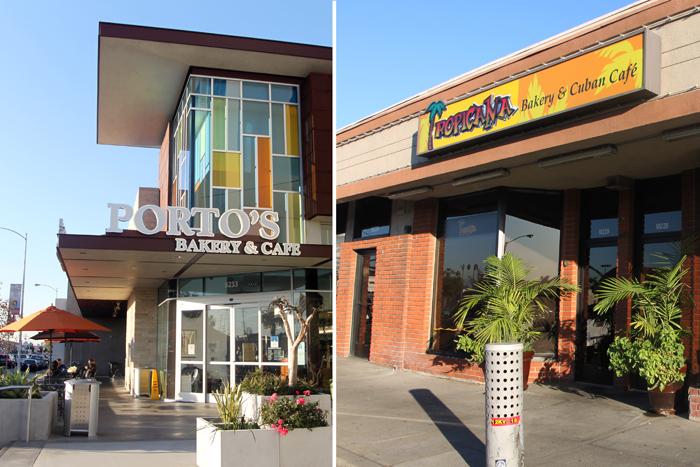With the hustle and bustle of city life thriving around it, the Tropicana, a Cuban bakery and café, invites onlookers into its homey interior to purchase their delicious goods. Likewise, Porto’s Bakery and Café also invites passers-by into its chic establishment. From afar, both businesses seem to be popular—but the question is, which is better? Both bakeries are Cuban based; both bakeries are packed any hour of the day. In comparing the two, one must account for four deal breakers: taste, diversity of options, price, and ambiance.
Aside from the rest of the aforementioned qualifiers, taste is the single most important aspect of any eatery. Based on taste alone, a business can either flounce or flourish. So how do both Cuban restaurants hold up? According to a small sample of customers surveryed, the food at either restaurant is delicious. At Tropicana, for example, most people, on a scale of one to five stars, rate the food at four and a half to five stars. Porto’s garners similar—if not better—results. Compared to one another, however, is when something surprising happens.
“I’ve had both Porto’s and Tropicana, and I am one hundred percent for Tropicana’s food,” resident Michael Angeles said. “Tropicana just has a more distinct Cuban taste. I like that.”
On the other hand, Porto’s customers find that the sweets are much better.
“I don’t know, I guess Porto’s is better,” Warren student Rachael Garcia said. “Like, the food tastes fresher, and their desserts have a sweeter taste. But I guess that is just me because I like sweet things.”
With specific regard to sweets and desserts, Porto’s Bakery wins almost every time. Interestingly enough, adolescents voted Porto’s over Tropicana on a much larger scale. According to most teens, the freshness and distinctively sugary attributes of Porto’s baked goods win out. Adults, on the other hand, preferred much more subtle flavors; naturally, they were inclined to Tropicana.
When comparing actual food, the Tropicana, with regards to persons asked, was commonly held above the other eatery. The Tropicana simply has more flavor, customers say. When Madeline Bauer was asked what she liked about her dish, Ropa Vieja, she responded by saying:
“I love how it doesn’t have too much garlic or onion. I have had some really bad Ropa Vieja because it was just too much. The meat is delicious, too. The flavors all just go together good. It is really delicious! This was well worth the price.”
On the other side of the spectrum, customers hold similar reviews for most of Porto’s courses. Yet, there are complaints: the tuna and chicken melts are said to contain too much celery and onion; the customary banana chips are sometimes too salty; fruit salads are mildly displeasing. That is not to say that its competitor is not without fault. The rice is sometimes bland, and the food is too saucy.
As it stands, Porto’s wins in the bakery department while the Tropicana champions the food section.
Yet, how do the two eateries vary if they are both Cuban? The Tropicana serves food that is much more traditionally Cuban. Along with that, the diversity of the menu is also quite small. On the other side, Porto’s menu is much wider and offers choices from all around. The bakery manages best with different types of sandwiches. If one is averse to strictly Latin food, the Tropicana would not be advised. If something worldlier is desired, Porto’s is the best bet.
Price is also a heavy determinate. On a strictly main-course approach, the Tropicana is relatively pricier. The cheapest entree is 9 dollars; the costliest entree is 12. However, there is still hope for those on a budget, as their a la carté menu offers some comparably cheap choices. The cheapest option on the menu is .85 cents, and the priciest item is 2.25. Porto’s least pricy sandwich is 4.15; its most expensive is 6.70. The salads and drinks also vary. Both restaurants cakes and pastries are priced within the same range.
The mood and setting of both establishments also drastically vary. Tropicana is much more homely, with Latin music constantly playing in the background. Hispanic art adorns the walls of the small building, and the walls are painted dark, earthy colors such as red and brown. The staff also wears matching outfits, with fedoras, khaki shorts, and a white shirt as the dress code. The mood is very relaxed, and the din of utensils upon glassware mixes with the small conversations going all around. Religious symbolism is also evident—this mixes very well with the blatantly Cuban atmosphere of the Tropicana.
Porto’s is nothing at all like its competitor. The Bakery and Cafe is much more modern and stylish, with an emphasis on openness and sharp, contrasting angles. Porto’s looks like a cubism piece. The mood is also a lot less heavy than its competitor. Porto’s strives to be a friendly, hip attraction, which it does very well. Something most noticeable about the bakery is its lightness. The restaurant is very bright and focuses mainly on colors such as white. Although the two businesses contrast, in the end either bakery is perfectly suitable for any person. Service at both restaurants is excellent as well. The staff is friendly and helpful, and strives to make every customer a happy customer.
In the end, the choice of which is better all comes down to personal preference. The Tropicana and Porto’s are diverse enough to be palatable to any assortment of people. Although they are both Cuban run, they appeal to very different sets of people—a fact that makes bakeries thrive.





Rod • Feb 12, 2016 at 4:25 PM
Both are great, but there are a couple of other Cuban establishments in Downey that should be mentioned!
Florida- on Lakewood near Florence. Not a bakery, but hands-down has the best Cuban food.
Havana Cafe- on Firestone and Old River School Rd. I haven’t been, so I can’t judge